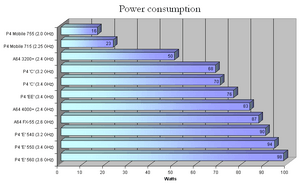Power consumption facts for kids
Power consumption is all about how much electrical energy a device uses every second to work. Think of it like how much fuel a car needs to run! We usually measure power consumption in units called watts (W) or kilowatts (kW). A kilowatt is 1,000 watts. This helps us understand how much electricity things like your refrigerator or television are using.
Why Devices Use Power
Every electronic device, from your phone charger to a big washing machine, needs electricity to do its job. When you plug something in, it starts pulling power from the electrical outlet. This power makes the device work, whether it's lighting up a room, making music, or cooling your food.
How Energy Gets Used
When a device uses power, it's converting electrical energy into other forms of energy. For example:
- A light bulb turns electrical energy into light and heat.
- A fan turns electrical energy into movement (to create wind).
- A computer turns electrical energy into calculations and light for the screen.
Why Some Energy is Wasted
You might be surprised to learn that no device is 100% efficient. This means that the energy a device uses is always more than the energy it actually needs to do its main job. Some of the electrical energy gets wasted, usually as heat.
For example, when a light bulb is on, it gets warm. That warmth is energy that didn't become light. Other ways energy can be wasted include:
- Heat: Most devices get a little warm when they are working.
- Vibrations: Some devices might vibrate slightly, which also uses up a tiny bit of energy.
- Electromagnetic radiation: While some devices are designed to produce this (like a radio), sometimes it's an unintended energy loss.
Understanding power consumption helps us choose devices that use less energy, which is good for our electricity bills and the planet!


